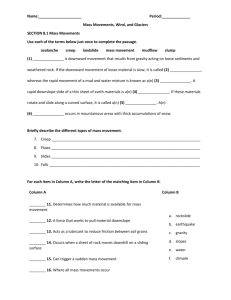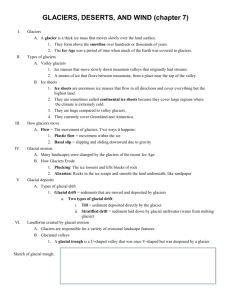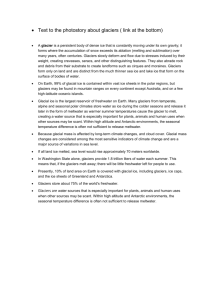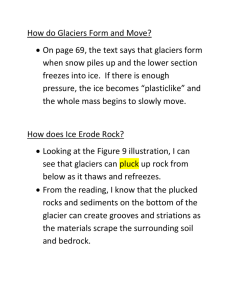Chapter 7 Student Presentation Notes 2nd Block Types of Glaciers
advertisement
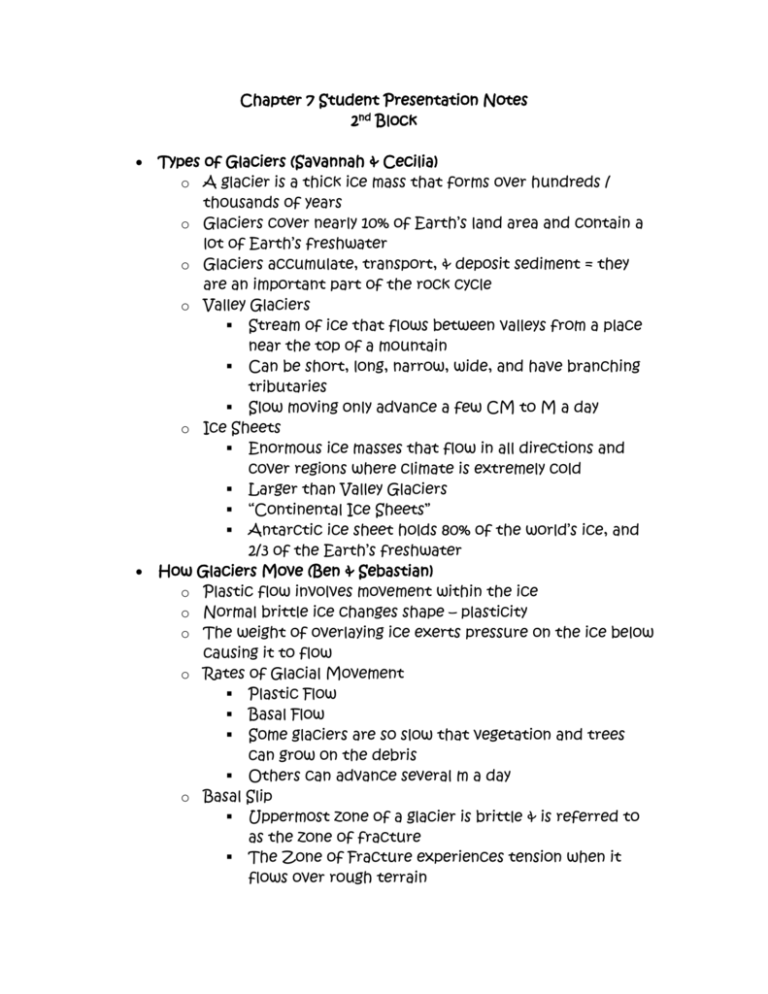
Chapter 7 Student Presentation Notes 2nd Block Types of Glaciers (Savannah & Cecilia) o A glacier is a thick ice mass that forms over hundreds / thousands of years o Glaciers cover nearly 10% of Earth’s land area and contain a lot of Earth’s freshwater o Glaciers accumulate, transport, & deposit sediment = they are an important part of the rock cycle o Valley Glaciers Stream of ice that flows between valleys from a place near the top of a mountain Can be short, long, narrow, wide, and have branching tributaries Slow moving only advance a few CM to M a day o Ice Sheets Enormous ice masses that flow in all directions and cover regions where climate is extremely cold Larger than Valley Glaciers “Continental Ice Sheets” Antarctic ice sheet holds 80% of the world’s ice, and 2/3 of the Earth’s freshwater How Glaciers Move (Ben & Sebastian) o Plastic flow involves movement within the ice o Normal brittle ice changes shape – plasticity o The weight of overlaying ice exerts pressure on the ice below causing it to flow o Rates of Glacial Movement Plastic Flow Basal Flow Some glaciers are so slow that vegetation and trees can grow on the debris Others can advance several m a day o Basal Slip Uppermost zone of a glacier is brittle & is referred to as the zone of fracture The Zone of Fracture experiences tension when it flows over rough terrain Tension causes cracks called crevasses o Budget of a Glacier Glaciers form where more snow falls than can be melted in the summer Snow accumulates and ice forms at the head of the glacier called the Zone of Accumulation Snowfall thickens and causes movement Area beyond the snowline is called the Area of Wastage o How Glaciers Move Calving creates icebergs when ice meets the ocean Calving is just massive chunks of ice breaking off the edge of a glacier Icebergs are less dense than water which causes then to float When you see an iceberg you only see the top 10% of it so literally you are seeing the tip of the iceberg Glacial Erosion (Carolina & Macy) o Ice tears rock from the inside of valleys o Hold everything they pick up until they melt o From the most recent ice age landscapes were changed by glaciers o Plucking Surfaces of rock beneath glaciers are broken up as melted glacial water penetrates the cracks The water refreezes and expands, prying the rock apart As the glacier moves across the fractured surface it incorporates blocks of rock into its ice o Abrasion As glacial ice and rock fragments move over bedrock, it works like sandpaper to smooth out the surface below By the glacial gristmill, pulverized rock is produced called rock flour So much of this produced that the meltwater leaving the glacier has a grayish appearance o Four Factors of Erosion Rate of glacial movement Thickness of ice Shape, abundance, and hardness of rock fragments in the ice at the base of the glacier Type of surface below the glacier Landforms created by Glacial Erosion (Olivia & Ja’Reighyah) o Glaciers are responsible for a variety of landscapes o Erosion by glaciers produce many features in mountainous areas o Glaciated Valleys Prior to glaciation alpine valleys were V-shaped due to downcutting of streams Glaciers widen, deepen, and straightens valleys, changing the V-shape to a U-shaped valley U-shaped valleys are called Glacial Troughs o Cirques A bowl shaped depression at the head of a glacial valley Surrounded on 3 sides by steep rock walls, which are the focal point of the glacier’s growth Glaciers carry away Cirques acting as a conveyer belt to move debris o Arêtes and Horns Arêtes – snaking sharp edged ridges Horns – sharp pyramid like peaks Horns form around cirques on the sides of mountains Arêtes form on opposite sides of a divide from a cirque Glacial Deposit (Chance & Paxton) o Glaciers transport huge loads of debris as they slowly advance across the land leaving sediment as it melts o There are 2 types of glacial drifts: Till & Stratified Drift o Till Deposits Deposited directly by glaciers Ice cannot sort the sediment it carries Those deposits are normally unsorted mixtures of different particle sizes o Stratified Drift Sorted by size & weight of the debris Some deposits of drift are sorted by size and weight of the debris Stratified drift is made mainly of sand and gravel Moraines, Outwash Plains, & Kettles (Caitlin C, Sierra, & Tristan) (Evan, Hannah, & Nick) o Lateral Moraines Ridges that form long the side of glacial valleys when a glacier melts and leaves gathered materials Medial moraines form when 2 valley glaciers join to make a ice stream o End Moraines & Ground Moraines Ground moraines form when glaciers began to withdraw Form gently rolling plains instead of ridges End moraines formed from debris caused by melted ice The longer the glacier remains stationary, the larger the end moraine grows o Terminal & Recessional Moraines Remain stationary for a short period of time Repeats many times before glacier completely melts o Outwash Plains Water flowing from the glacier containing fine sediment slows down and drops sediment in ramp like structures called outwash plain Downstream from the end moraines o Kettles Depressions in small lakes Form when a big block of ice gets buried in a drift and melts Melting leaves glacier sediment with pits o Drumlins & Eskers Eskers are snake like ridge made of sand and gravel from streams that flowed through glaciers Drumlins are a landform made from tills of glaciers they are steep on the side and can be as tall as 60 m Glaciers of the Ice Age (Makayla & John) o Glaciers covered almost 30 % of Earth’s land o Most recent ice age was 2-3 million years ago o Many major glacial episodes occurred during Pleistocene Period o Glaciers store 75% of earth’s freshwater Geologic Processes in Arid Climates (Kaitlyn & Juston) o Arid climates are hot & dry & have sharp rocks and steep canyons o Covered in dust and pebbles o Weathering Weathered debris in a desert is the result of mechanical weathering Chemical weathering does not happen as often because there is a lack of acidic organic material o Role of Water There are always riverbeds in the desert, but most of the time they are dried up These channels carry water when it rains which is rare Flash flooding in the desert is common when it rains, but the water is gone quickly because the soil does not soak it up Basin / Range: A Desert Landscape (Claire & Will) o Playa Lake o Alluvial Fan o Water in the Desert Arid / Desert regions generally lack permanent streams and complex drainage systems because desert streams are usually evaporated or they seep in the soil through infiltration long before they can ever reach the sea Most desert erosion is the result of running water, not wind erosion o Exceptions When most dry out some streams or rivers like the Nile in NE Africa manage to flow through the heat Loss of energy results in the release of the majority of the eroded material which creates alluvial fans Playa Lakes form because of heavy precipitation, are even rarer Playa lakes are thin lakes that do not exist for a long They form on the basin’s floor after possibly flowing across alluvial fans The bed of the lake that is left after it dries up is called a playa Wind Erosion (David & Karlee) o About Wind Erosion Wind erodes in the desert by deflation & abrasion Deflation – lifting and removal of loose particles Abrasion – the process of scraping or wearing away Ex) Dust Bowl Wind Deposits (Miceala & AJ) o Wind creates landform by depositing sediment o Loess & sand dunes are landscape features deposited by wind o Loess Windblown silt that blankets the landscape Dust storms pick up the material, transport it, then deposit it o Sand Dunes Wind releases its load of sediment when velocity (speed) falls and the energy available to move lessens Sand accumulates when obstruction crosses its path and slows its movement Dunes occur when the wind encounters an obstruction and the velocity (speed) falls and the sand particles fall Dunes are usually more steeper on sheltered side and more of a gentle slope on the side of the wind Cross beds happen when sand is deposited on the sheltered side of the dune, creating layers inclined in the direction wind is blowing Types of Sand Dunes (Conner & Courtney) o Form when wind deposits sand in mounds and ridges o Can occur in places where the wind encounters and obstruction o 6 different types of sand dunes o Transverse Dunes Ridges are perpendicular to the wind direction Typically found in coastal areas o Star Dunes Form when the area has a complex wind regime, where the wind blows in various directions o o o o o Star dunes will have at least 3 or more arms Barchanoid Dunes Common dune Form at right angles Longitudinal Dunes Long ridges of sand that are parallel to the wind Occur where sand supplies are moderate Parabolic Dunes Sand sheet is covered in vegetation When wind pushes the sand in a forward motion, it moves Barchan Dunes Solitary sand dunes shaped like a crescent These form on flat, hard grounds They reach heights of about 30 ft.

